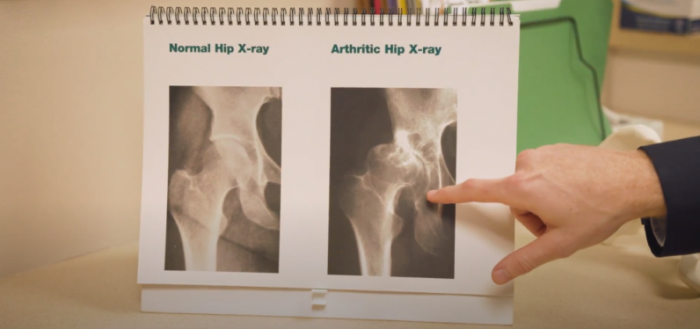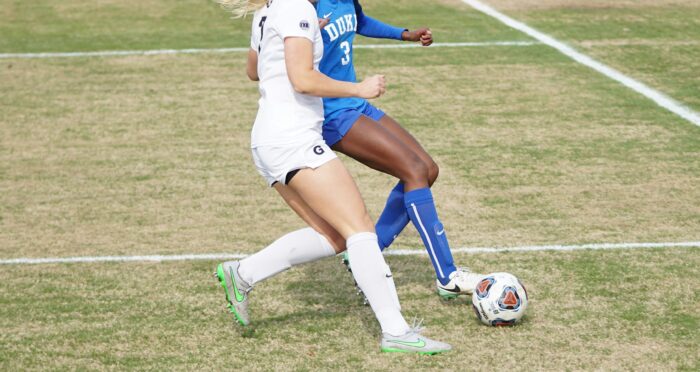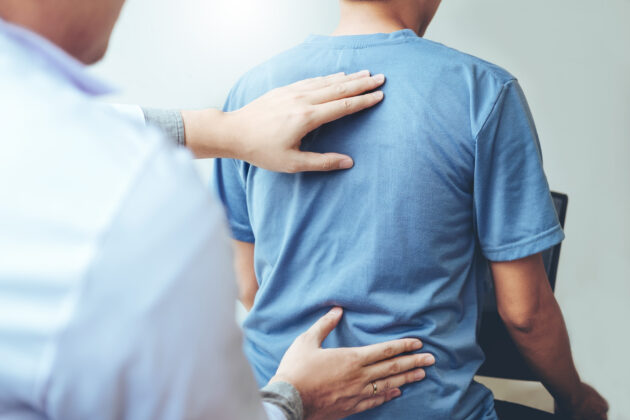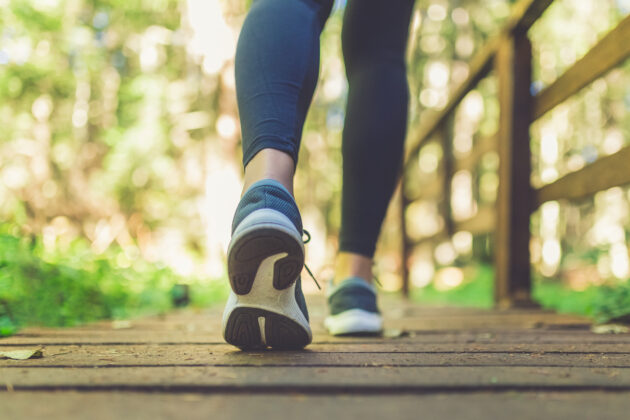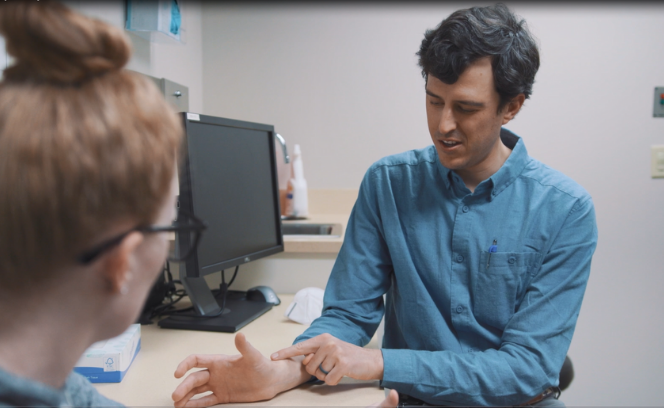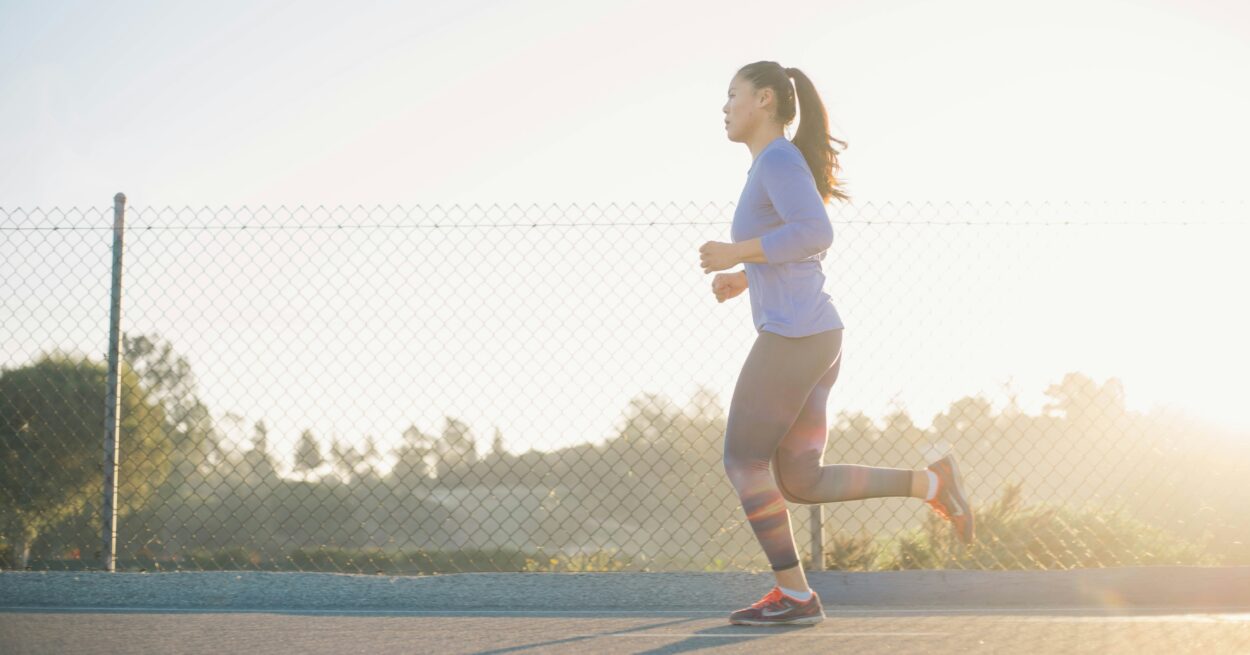
One of the most common problems in active women is anterior knee pain, or pain that occurs in the front and center of the knee. Women are predisposed to this type of pain because of a combination of anatomy and muscle imbalances. It can come on suddenly and cause discomfort with daily activities and sports, and may even disrupt your sleep.
The anatomy of the knee allows the leg to bend and straighten, and includes the femur (thigh bone), tibia (leg bone), and patella (knee cap) working together with the quad muscles and tendons. Every time you put weight on the leg or flex the quad, it engages this extensor mechanism and the joint between the knee cap and femur gets loaded. The other muscles that play a key role optimizing hip and knee function include the gluteus muscles and hamstrings, as well as the IT band, which is the thick band of tissue and muscles that run on the outside of your leg between the knee and hip.
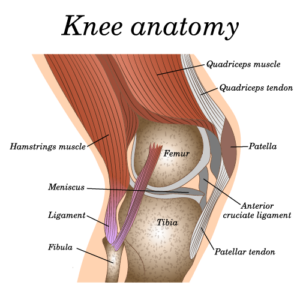
Causes of Anterior Knee Pain
Because women have wider pelvises and tend to be more knock kneed than men, several things can happen when they load the knee joint (i.e. running, jumping, squatting, climbing stairs, etc.). An abnormal kneecap movement over the front of the knee or overtightened soft-tissues on the front or side of the knee can commonly lead to anterior knee pain over time. In addition, women tend to rely on the quad muscles for all loading activities and may have weaker glute and hamstring muscles. This muscle imbalance can lead to pelvic instability, which can impact leg and knee alignment. Women with flat feet are also more likely to develop anterior knee pain.
Symptoms of Anterior Knee Pain
The symptoms of anterior knee pain include the following:
- Increased pain in the front of the knee with activities like going up or down stairs, kneeling, squatting, lunging, running, and jumping
- Difficulty fully straightening the leg
- Pain with prolonged sitting with the knee flexed, especially if the feet are dangling
- Pain while sleeping at night
- Pain in the back of the knee (referred)
- Vague and achy in nature, but can be burning or sharp with loading
- Popping/crunching/grinding in the front of the knee when bending/extending
Examination of Anterior Knee Pain
The examination process involves assessing various factors contributing to anterior knee pain:
- Glute Strength Evaluation: Weakness in the gluteal muscles can contribute to altered biomechanics and increased stress on the patellofemoral joint. Your orthopedic surgeon will assess the strength of the gluteal muscles to determine if weakness is a contributing factor.
- Hamstring and IT Band Flexibility: Tightness in the hamstrings and iliotibial (IT) band can alter the mechanics of the knee joint, potentially worsening anterior knee pain. Evaluating the flexibility of these structures helps identify areas requiring targeted stretching and mobility exercises.
- Assessment of Kneecap Alignment and Mobility: The orthopedic surgeon examines the alignment and mobility of the kneecap (patella) to identify any abnormalities such as tightness or hypermobility. Grinding or popping sensations during knee movement may indicate patellar malalignment or instability.
- Examination for Pain Patterns: Pain patterns around the IT band and kneecap, both at rest and during flexion and extension movements, provide valuable diagnostic information. Understanding when and how pain manifests helps tailor treatment strategies.
- Evaluation for Joint Swelling, Instability, Numbness, or Tingling: Unlike other knee conditions, anterior knee pain typically does not present with joint swelling, instability, numbness, or tingling. Absence of these signs helps differentiate patellofemoral pain syndrome from other injuries or conditions.
Treatment of Anterior Knee Pain
Treatment of anterior knee pain, often termed patellofemoral pain syndrome, typically avoids surgical intervention. Instead, the focus is on conservative management and addressing underlying biomechanical issues:
- Physical Therapy: Targeted exercises aimed at strengthening weak muscles, improving flexibility, and correcting faulty movement patterns play a central role in rehabilitation.
- Activity Modification: Avoiding activities that worsen symptoms, such as deep squats or prolonged kneeling, helps alleviate stress on the patellofemoral joint.
- Orthotics or Bracing: Orthotic devices or braces may be prescribed to correct foot alignment and provide additional support to the knee joint during weight-bearing activities.
- Pain Management: Nonsteroidal anti-inflammatory drugs (NSAIDs), and icing may help manage pain and inflammation in the acute phase of treatment.
- Education and Lifestyle Modifications: Patient education on proper biomechanics, posture, and ergonomics can prevent recurrence and promote long-term joint health.
Surgery is typically reserved for cases of anterior knee pain that did not respond to conservative treatment options. However, the majority of patients experience significant improvement with non-surgical interventions.
Recovering from Anterior Knee Pain
“Recovering from anterior knee pain is usually very successful, especially if patients commit to their rehabilitation exercises and strengthen their core, glute, and hamstrings,” said Ekaterina Urch, MD, orthopedic surgeon at The Center Orthopedic & Neurosurgical Care. “Modifying activities is crucial to mitigate the pain. For example, women who primarily run are encouraged to take up cross training like biking, rowing, or swimming. Yoga can also be an excellent addition to any active woman’s exercise regimen.”
Runner’s Knee
Runner’s knee, also known as patellofemoral pain syndrome (PFPS), is a common condition among runners and athletes that results in pain around the kneecap (patella). Symptoms of runner’s knee can vary in severity and presentation, but they often include:
- Pain Around the Kneecap: The primary symptom of runner’s knee is pain around or behind the kneecap, particularly during activities such as running, squatting, climbing stairs, or sitting for prolonged periods with the knees bent.
- Pain with Activity: Pain typically worsens with activities that involve bending the knee, such as running, jumping, or squatting. However, in some cases, pain may also occur during periods of rest or with prolonged sitting.
- Swelling: Swelling around the knee joint may accompany runner’s knee, although it is not always present. Swelling can contribute to discomfort and may limit range of motion.
- Crackling or Popping Sensations: Some individuals with runner’s knee may experience crackling or popping sensations when bending or straightening the knee. These noises, known as crepitus, can be indicative of irregularities in the movement of the patella.
- Difficulty Descending Stairs or Hills: Runner’s knee may cause difficulty when descending stairs or hills due to increased pressure on the patellofemoral joint during these activities.
- Pain During or After Physical Activity: Pain may start during physical activity and continue afterward, persisting for hours or even days after exercise.
- Tenderness to Touch: The area around the kneecap may be tender to the touch, especially along the edges or underneath the patella.
- Stiffness or Tightness in the Knee: Some individuals may experience stiffness or a feeling of tightness in the knee joint, particularly after periods of inactivity or rest.
It’s important to note that the severity and duration of symptoms can vary among individuals with runner’s knee. While some may experience mild discomfort that resolves with rest and conservative measures, others may have persistent or recurrent symptoms that require more intensive treatment, such as physical therapy or orthopedic intervention.
Runner’s Knee vs Anterior Knee Pain
Runner’s knee and anterior knee pain are two terms often used interchangeably, but they can refer to slightly different conditions, though there can be overlap in symptoms and causes. While runner’s knee specifically refers to pain around the kneecap due to patellofemoral joint issues, anterior knee pain is a broader term encompassing various conditions that cause discomfort in the front of the knee. Both conditions may share similar symptoms and risk factors, but the underlying causes and treatment approaches can differ based on the specific diagnosis. It’s important for individuals experiencing knee pain to seek evaluation from an orthopedic surgeon specializing in the knee for an accurate diagnosis and appropriate management plan.
Preventative Exercises for Knee Pain
Preventative exercises for knee pain in women can help strengthen the muscles around the knee joint, improve flexibility, correct imbalances, and promote proper biomechanics. Here are some exercises that can be beneficial:
- Quad Strengthening Exercises:
- Straight Leg Raises: Lie on your back with one leg bent and the other straight. Lift the straight leg toward the ceiling, keeping it straight, then slowly lower it back down.
- Quad Sets: Sit with your legs extended and push the back of your knee down into the floor, tightening your quadriceps muscle. Hold for a few seconds, then relax.
- Wall Sits: Stand with your back against a wall and slide down until your knees are bent at a 90-degree angle. Hold this position for 30 seconds to 1 minute, then stand back up.
- Hamstring Strengthening Exercises:
- Hamstring Curls: Lie on your stomach with your ankles secured under a low bench or have a partner hold them. Bend your knees to bring your heels towards your buttocks, then slowly lower them back down.
- Romanian Deadlifts: Stand with feet hip-width apart, holding dumbbells or a barbell in front of your thighs. Hinge at the hips and lower the weights towards the floor while keeping your back straight, then return to standing.
- Glute Strengthening Exercises:
- Hip Bridges: Lie on your back with your knees bent and feet flat on the floor. Lift your hips towards the ceiling, squeezing your glutes at the top, then slowly lower back down.
- Clamshells: Lie on your side with your hips and knees bent. Keeping your feet together, open your top knee as far as you can, then return to the starting position.
- Hip and IT Band Stretching:
- IT Band Stretch: Stand with one foot crossed over the other and lean to the side, reaching towards the opposite side with your arm. Hold for 15-30 seconds, then switch sides.
- Piriformis Stretch: Sit with one leg crossed over the other and the foot of the top leg placed near the knee of the bottom leg. Lean forward until you feel a stretch in the buttocks. Hold for 15-30 seconds, then switch sides.
- Core Strengthening Exercises:
- Plank Variations: Perform planks on your hands or forearms, focusing on maintaining a straight line from head to heels.
- Russian Twists: Sit on the floor with your knees bent and feet lifted off the ground. Hold a weight or medicine ball and rotate your torso from side to side.
- Low-Impact Cardio Exercises:
- Activities like swimming, cycling, or using an elliptical machine can help improve cardiovascular health and strengthen the muscles around the knee joint without placing excessive stress on it.
It’s essential to perform these exercises with proper form and technique to avoid injury. Additionally, if you have existing knee pain or any underlying medical conditions, consult with your provider before starting a new exercise program. They can provide guidance tailored to your individual needs and help you prevent knee pain effectively.
